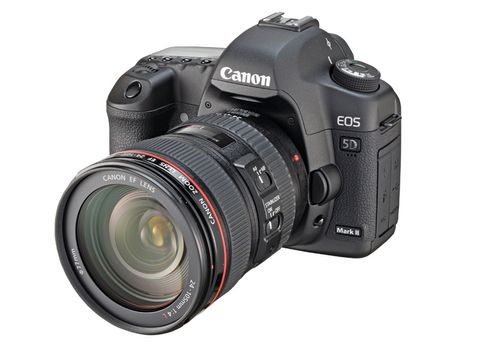TechRadar Verdict
If looks, build, design and handling were the only criteria, the EOS 5D Mk II would perhaps be the most desirable full-frame SLR of all. But the D700 and the Sony a900 are both so good for picture quality that, despite its 21 million pixels, the Canon has a real fight on its hands
Pros
- +
Live View
- +
21 MP
- +
Dual function buttons
Cons
- -
Fiddly white balance controls
- -
Lens
- -
Need to shoot in RAW to get the most out of it
Why you can trust TechRadar
The Canon EOS 5D was a revelation. But a lot has happened since then. Nikon and now Sony have full-frame sensors.
So while the Canon EOS 5D Mk II is a major development of the original, it's never going to enjoy the same near-monopoly as its predecessor. So what's changed?
The new bits
The sensor resolution has gone up from 12.8 megapixels to 21. The 2.5-inch 230,000 pixel LCD has been replaced with one half an inch larger and with four times the resolution. And the new 5D has technology inconceivable when the original 5D was launched, notably a Live View mode and a 1920 x 1080 HD movie mode... we were impressed with the D90, but this is something else again.
The definition is such that there must be more than a few mid-high end camcorder makers starting to wonder if they've backed the wrong horse. Canon's latest Digic IV processor means that the new camera can shoot at 3.9fps compared with the old camera's 3fps, and it handles these big files very well.
In our tests the camera matched Canon's claim of 13 consecutive RAW files at full speed, but it did slow down after that and, once the buffer was full, it took around 20 seconds to clear.
High ISO
Other, less obvious enhancements include a larger, brighter viewfinder, two 'silent' Live View modes for unobtrusive photography, an ISO increase to 6400 in normal shooting and an amazing 25600 in 'expanded' mode.
An Auto Lighting Optimiser extends the camera's dynamic range, opening up shadows without sacrificing highlights, and a peripheral lighting option promises to reduce or remove any corner shading caused by your Canon lenses.
Design and handling
Much of the 5D Mk II's appeal, though, is tied in with its handling rather than its technology. The appearance and layout will be instantly familiar to anyone who's used a high-end EOS before, but Canon has tweaked and reined the user interface to make it better than ever.
Like other pro cameras, this one has two control dials. The first is mounted in the conventional location on the top of the grip. The second, though, is a much larger dial which lies flat on the back of the camera.
Its size and its knurled edge make it very easy to spin with your thumb. Twin control dials mean it's much easier to make independent shutter speed and aperture adjustments, but this rear dial does a lot more.
It's used for menu navigation too – a small joystick just above can be used to move between the menu tabs, but you move down the options by 'spinning' the rear dial. It's both fast and precise. But there's one more twist.
Quick controls
Interactive LCDs have proved their worth in amateur cameras, notably Olympus's E-series and the Nikon D60. They have the advantage that they both show the current settings and enable you to change them directly. And that's just what Canon's introduced on the 5D Mk II. You can stick to the traditional control method if you prefer, or use the new interactive 'Quick Control Screen' instead.
The big question is whether the 21-million pixels have made a big difference to the image quality. One worry will be that the higher pixel density harms the high ISO performance, but in fact the image quality at ISO 6400 is strikingly good. As good as the Nikon D700/D3? Maybe, maybe not. But it's impressive.
What's clear, though, is that the increased resolution really puts the emphasis on lens quality. We tested the 5D Mk II with the 24-105mm f/4 IS lens usually supplied with it as a kit, and found the performance to be good but not exceptional, and this includes some chromatic aberration at the edges of the frame at shorter focal lengths that you might not be expecting to see.
Having said that, the Digital Photo Professional RAW converter/editor supplied with all EOS SLRs has an option to fix this. It can dial out lens aberrations including chromatic aberration, distortion and corner shading automatically, using the lens data and settings embedded in the image's EXIF data.
Digital Photo Pro is sometimes overlooked, but it's a very capable program. In particular, it reveals a lot more fine, textural detail than you tend to see in the 5D Mk II's JPEGs.
JPEG vs. RAW
Like other EOS SLRs, this camera produces clean, noise-free JPEGs but at the cost of fine, high-frequency information. It doesn't affect every image by any means, but there are some subjects in some lighting where the surfaces and the details seem to drop below the camera's detail 'threshold' and are rendered with a characteristically 'glassy' look.
This shouldn't trouble potential 5D Mark II owners, partly because the files are so large that the detail involved is very small and partly because most are likely to shoot RAW anyway. And this is where the Digital Photo Pro software ties in perfectly with the camera, duplicating the Picture Styles, white balance presets and other on-camera adjustments.
Ultimately, the 5D Mk II no longer has a single, conclusive advantage – it's going to have to rely on a combination of things, like its Live View, its HD movie mode and, perhaps most of all, its superb build, design and handling and the backup of Canon's extensive and long-established professional lens and accessory range.
Via PhotoRadar

